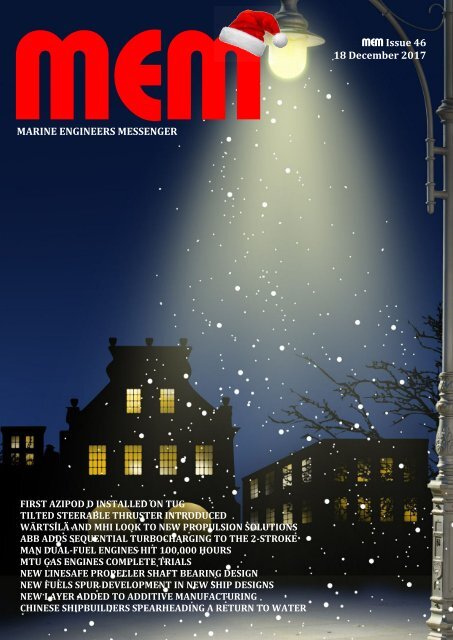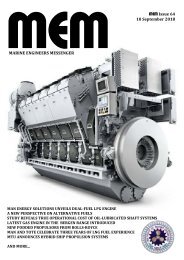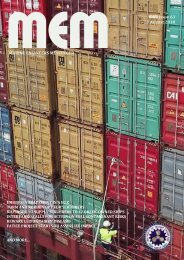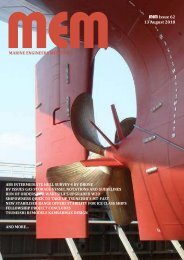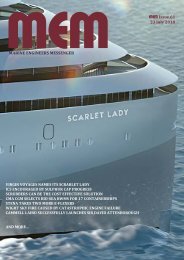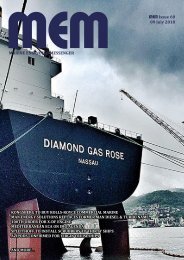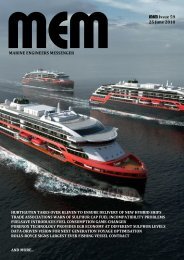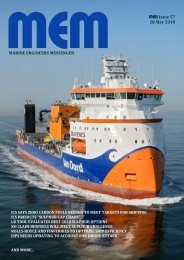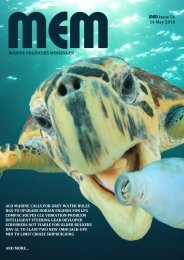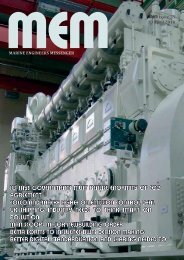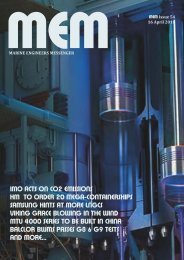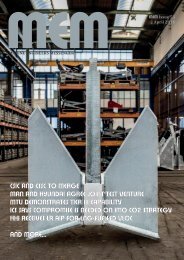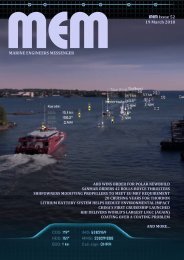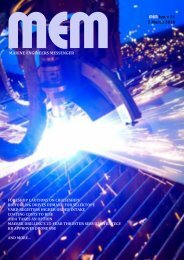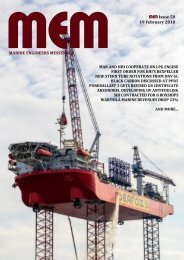MEM46
Marine Engineers Messenger, Volume 2, Issue 46
Marine Engineers Messenger, Volume 2, Issue 46
You also want an ePaper? Increase the reach of your titles
YUMPU automatically turns print PDFs into web optimized ePapers that Google loves.
MEM<br />
MEM<br />
MARINE ENGINEERS MESSENGER<br />
Issue 46<br />
18 December 2017<br />
FIRST AZIPOD D INSTALLED ON TUG<br />
TILTED STEERABLE THRUSTER INTRODUCED<br />
WÄRTSILÄ AND MHI LOOK TO NEW PROPULSION SOLUTIONS<br />
ABB ADDS SEQUENTIAL TURBOCHARGING TO THE 2-STROKE<br />
MAN DUAL-FUEL ENGINES HIT 100,000 HOURS<br />
MTU GAS ENGINES COMPLETE TRIALS<br />
NEW LINESAFE PROPELLER SHAFT BEARING DESIGN<br />
NEW FUELS SPUR DEVELOPMENT IN NEW SHIP DESIGNS<br />
NEW LAYER ADDED TO ADDITIVE MANUFACTURING<br />
CHINESE SHIPBUILDERS SPEARHEADING A RETURN TO WATER
MEM<br />
MARINE ENGINEERS MESSENGER<br />
MEM Issue 46<br />
18 December 2017<br />
Telegraph<br />
A<br />
s we near the end of a year in which the maritime industry was made painfully aware of the commercial,<br />
safety and reputational impact of a cyber-attack, what do the cybermen have in store for 2018?<br />
There is no doubt that cyber-crime is on the rise across all industries, but the maritime industry is at<br />
particular risk, with cyber criminals seeing the sector as a soft target with easy pickings.<br />
They’re right. For whatever reason, the industry has been slow in implementing measures to properly<br />
protect systems and data and there are still some manufacturers supplying equipment that does not have the<br />
level of protection required to completely safeguard against intrusion. This must change, and change quickly.<br />
Criminals follow the money and there’s big money to be made not only from maritime industry data – as we<br />
saw last month from the hacking of shipbroker Clarksons – but also from the high-value cargoes that vessels are<br />
transporting.<br />
Imagine. It’s the dead of night and your ECDIS shows you’re making good headway to unload containers at<br />
Singapore, when, in reality, you’re heading towards the Gulf of Aden and a nefarious gang of pirates. You may<br />
think this scenario is far-fetched, but when you consider navigating officers are relying more and more on the<br />
information they see on screen, and less on their senses, it’s not so implausible.<br />
The impact of cyber-crime on the cruise sector is even more worrisome. Imagine passengers preparing for<br />
dinner and the evening's entertainment when the ship experiences a complete black out. Dead ship. Passengers<br />
stuck in elevators, no aircon, no lights, no dinner, no entertainment. All ship systems completely blocked until<br />
Micky Arison or whoever pays the ransom. It's scary stuff.<br />
Naval Dome, the Israel-based cyber security company, anticipates that ransomware attacks will increase<br />
next year, becoming more indiscriminate in scope and volume and that this particular threat will also begin to<br />
extend to crew members’ smartphones, tablets and other mobile devices. These could become targeted by<br />
attackers as they provide an easily-hacked and often unprotected gateway to internet-connected ship systems.<br />
They could also be hacked to extract personal data with which to blackmail crew and staff.<br />
The Internet of Things and the growth in cloud-dependent systems appeals to the cyber-criminal, but<br />
presents considerable challenges for the maritime industry. We are already seeing a sharp rise in attacks using<br />
malware, such as Industroyer, which has hit some shore-side infrastructure and industrial equipment. And for<br />
land-based industry this is considered the greatest threat to industrial control systems. This threat will be<br />
exacerbated as it becomes more difficult to verify the authenticity of system upgrades and patches.<br />
Just a few years ago, there were numerous press reports advising the industry that 90% of all cyber-attacks<br />
can be prevented by operators simply patching regularly, downloading software updates, frequently changing<br />
passwords and log-ins, and generally being more cyber aware. But this now offers a false sense of security. The<br />
systems and methods criminals are using today can easily hurdle these obstacles, without you ever knowing.<br />
Indeed, your systems could be infected right now, and the criminal is just biding time, waiting for the optimum<br />
opportunity to activate the virus.<br />
It is encouraging that there is now more of an understanding of the seriousness of the threat and that<br />
concerted efforts are being made to better protect the global maritime industry. What is not so encouraging is<br />
the dichotomy between the speed with which decisions are made and the speed with which cyber criminals<br />
develop new viruses.<br />
The IMO Maritime Safety Committee, for instance, has adopted resolution MSC.428.98, Maritime Cyber Risk<br />
in Safety Management Systems, the tenet of which is to ensure cyber risks are appropriately addressed in the<br />
ISM Code. But by the time cyber security becomes mandatory in three years’ time it may be too late for many<br />
vessels and fleets.<br />
Naval Dome has a complete, approved and certified solution available now.<br />
3
PROPULSION<br />
FIRST AZIPOD D FOR TUG<br />
ABB has revealed that an<br />
8000kW rescue tug, the first<br />
vessel installed with its Azipod<br />
D electric propulsion system,<br />
has been delivered to customer<br />
Guangzhou Salvage Bureau, a<br />
division of the Chinese Ministry<br />
of Transport. The vessel was<br />
built by Huangpu Wenchong<br />
Shipyard.<br />
Before delivery, the rescue<br />
tug was tested in sea trials<br />
where it exceeded design targets<br />
in bollard pull, fuel economy,<br />
manoeuvrability, and low-load<br />
performance.<br />
The Azipod D, available across a power range from 1.5 MW to 7.5 MW, incorporates ground-breaking<br />
thruster technology enabling installed power savings of up to 25%, less maintenance and significantly reduced<br />
fuel consumption and emissions. Unique advantages make the design suitable for a wide range of vessel types.<br />
Captain Shaohua Liu of the rescue tug, said: “We are really impressed with the vessel’s performance. Response<br />
time and manoeuvrability, both of which are critical in our operations, are excellent. Less power was required<br />
than we expected for a given function. The Azipod D has exceeded our expectations by far.”<br />
Jaakko Aho, Vice President Thruster Products, ABB Marine & Ports, said: “The Azipod D range demonstrates<br />
our continuing drive to raise efficiency and cut lifetime running costs. More can now be achieved with less, and<br />
the scalable Azipod D is suitable for an even broader range of applications compared with earlier units.”<br />
Referring to the product range itself, he commented: “With proven reliability, lower installed power<br />
requirements, economic efficiency and reduced maintenance requirements, we are confident of outperforming<br />
our peers and strengthening our position as the supplier of choice for high-end thrusters.”<br />
TILTED STEERABLE THRUSTER INTRODUCED<br />
Wärtsilä has launched the WST-24R. A thruster which the manufacturer claims is the maritime industry's first<br />
tilted steerable thruster with combined electric retraction and steering.<br />
One of the most notable features of the WST-24R is the gearbox, which has an eight-degree tilted propeller<br />
shaft configuration. This is said to reduce thruster/hull interactional losses, thereby producing up to 20% more<br />
effective thrust than conventional non-tilted thrusters and enabling lower fuel consumption. This extra<br />
effective thrust directly contributes to the advanced DP capability of a vessel.<br />
Replacing the existing LMT 1510, the WST-24R thruster offers more than 10% added unit thrust as a result<br />
of the reduced power density. This, combined with improved hydrodynamics and the dedicated Wärtsilä<br />
Thruster Nozzle design, reduces the environmental impact of the propulsion system. It can<br />
also be delivered to comply with clean notations and is optionally<br />
compatible with the US EPA's VGP2013 stipulations.<br />
With fewer components, the thruster has been designed to<br />
reduce maintenance, while the combined steering-retraction<br />
seals, designed to have no oil to water interface to reduce<br />
environmental risk, can be replaced from inboard. The steering is<br />
electric, rather than hydraulic, further enhancing the capabilities<br />
of the system, and the new retraction system is lightweight and<br />
safe with self-locking electric actuation.<br />
Wärtsilä is marketing the WST-24R for application to<br />
shuttle tankers and offshore support and construction vessels.<br />
"This latest addition to our thruster offering increases<br />
operational efficiency for owners and operators, while the<br />
pre-aligned plug and play installation eases shipyard time<br />
and costs. There are other retractable thrusters of this size on the<br />
market, but the Wärtsilä WST-24R is the only one with the tilted<br />
configuration advantage," said Michel van Veluw, Director Thrusters<br />
& Propulsion Controls, Wärtsilä Marine Solutions.<br />
4
WÄRTSILÄ AND MHI LOOK TO NEW PROPULSION SOLUTIONS<br />
Wärtsilä and Mitsubishi Heavy Industries Marine Machinery & Equipment (MHI-MME) have signed a<br />
Memorandum of Understanding (MOU) to market a new energy solution capable of producing greater power<br />
generation capacity for marine vessels.<br />
By integrating MHI-MME's waste heat recovery system and energy saving power generation system (WHRS)<br />
with Wärtsilä's operational control technology for shaft generator systems, the new solution results in more<br />
energy efficient ship navigation and an improved Energy Efficiency Design Index (EEDI).<br />
A notable innovation is the combining of a power take off/take in (PTO/PTI) shaft generator system with the<br />
WHRS to improve the stability of the WHRS. Depending on the load of the main engine and the ship's network,<br />
the WHRS sometimes produces electrical energy in excess of that needed by the network. Such energy can be<br />
utilised via the PTO/PTI generator and at full load, the surplus energy can be used to assist the ship's drive by<br />
being applied directly to the propeller shaft. At low main engine load, the WHRS can be operated in parallel<br />
with a diesel generator set. Parallel operation with a shaft generator via PTO operation is also easily<br />
implemented.<br />
The patented design connects the WHRS generator into the DC link circuit of the PTO/PTI shaft generator<br />
rather than directly into the mains. This allows operation of the WHRS at reduced speed to create higher<br />
efficiency of the turbine system at part load. In so doing, it avoids the necessity of speed regulation valves,<br />
which cause throttle or bypass losses.<br />
"When two technology leaders combine their fields of expertise, as is the case here, a solution can be created<br />
that raises efficiency to a new level. This will produce obvious benefits for ship owners and operators, and we<br />
are proud to be cooperating with Mitsubishi in this exciting development," said Peter Rogers, Director, Power<br />
Conversion, Wärtsilä Marine Solutions.<br />
Tomoo Kuzu, Executive Vice President, MHI-MME, said: "We are moving forward various energy-saving<br />
technologies and can expand our portfolio with this new solution, which we are quite convinced will satisfy<br />
present market demands for increasing environmental awareness. We wish to thank Wärtsilä for its highquality<br />
collaboration that has made it possible.”<br />
MARINE ENGINEERS MESSENGER<br />
SHIP TECHNOLOGY NEWS TO 8544 DECISION MAKERS<br />
EVERY TWO WEEKS<br />
Click here for more information about our favourable advertising rates or<br />
email: mem@seabornecomms.com<br />
5
TURBOCHARGERS<br />
ABB ADDS SEQUENTIAL<br />
TURBOCHARGING TO THE 2-STROKE<br />
ABB Turbocharging has announced its<br />
Flexible integrated Turbocharging System for<br />
Two-Stroke Engines (FiTS2), a new sequential<br />
turbocharging system that is claimed to deliver<br />
engine fuel savings of up to 3%, depending on<br />
load profile.<br />
FiTS2 has been developed in close<br />
collaboration with low-speed two-stroke<br />
engine designer, Winterthur Gas & Diesel Ltd.<br />
(WinGD), which has developed a special tuning<br />
for FiTS2.<br />
The new technology enables two-stroke<br />
engine builders to offer more flexibility,<br />
increasing the potential for higher efficiency<br />
and lower operating costs for their customers.<br />
NOx emissions from engines fitted with FiTS2<br />
will remain within IMO Tier II limits.<br />
Additional abatement technologies like SCR or<br />
EGR can be used to comply with IMO Tier III<br />
NOx emissions and will not greatly affect the<br />
system while still delivering fuel saving<br />
benefits.<br />
Past high fuel prices and low vessel demand<br />
led to an increase in slow steaming for very<br />
large cargo ships, resulting at times in<br />
operation outside of original design parameters<br />
and therefore causing increased maintenance<br />
and repair costs. Typical fuel bills for such<br />
vessels have been cited by McKinsey & Co as<br />
the largest cost item for shipping lines and<br />
often exceeding 40% of all costs despite current<br />
lower oil prices.<br />
As the market continues to see the financial<br />
impact of overcapacities, FiTS2 is aimed at addressing the sustained cost versus operational flexibility<br />
challenge. FiTS2 could enable two-stroke engines to operate more efficiently at lower loads, while still<br />
enabling rapid return to full engine power without compromise on original design-point efficiencies. As a<br />
result, significantly higher savings could be achieved with FiTS2.<br />
“From an operator’s or charterer’s perspective, FiTS2 efficiency benefits will enable major cost reductions.<br />
Considering for example a typical current fuel bill of US$3 to 4 M per year for very large crude oil carriers,<br />
FiTS2 has potential to provide fuel cost savings of up to US$100,000 per year, compared with levels typically<br />
achievable using conventional turbocharging systems. Big savings are also possible for other vessel types, e.g.<br />
for container vessels and can amount to US$1 M or more over 10 years. The payback of initial costs can be less<br />
than two years, making the FiTS2 solution very attractive,” said Joachim Bremer, Head of Product Line Low-<br />
Speed, ABB Turbocharging.<br />
To optimise engine efficiency via improved turbocharging in low and part load, the engine runs in lower<br />
loads with only one turbocharger in operation, whereas at higher loads (typically above 50 to 60% engine<br />
load) two turbochargers operate simultaneously. The same principle is applied for very large engines – with<br />
FiTS2 they will run with two turbochargers in lower loads and with all three turbochargers for higher load<br />
operation. The specially designed cut-off valves for the FiTS2 system are flow-optimized and integrated with<br />
the turbocharger casings, ensuring a compact and lean design. Furthermore, the valves can be operated<br />
rapidly and automatically under load, without interrupting operation of the engine up to full load.<br />
Cut out of one turbocharger for lower engine loads leads to higher scavenging air pressure, increasing the<br />
compression ratio and firing pressure optimized by special tuning of FiTS2. The result is enhanced engine<br />
efficiency and lower specific fuel consumption while remaining compliant with emission regulations. Robust<br />
design and very wide compressor maps of ABB’s A100-L and A200-L turbocharger series allow switching<br />
under load without surging and there are no requirements for additional by-pass valves or pipework, making<br />
FiTS2 a uniquely simpler and relatively low-cost solution compared to any alternative.<br />
6
An additional benefit comes from the possibility to switch off the electrically-powered auxiliary blowers at<br />
25% engine load, instead of around 35% load. This enables additional savings via reduced power consumption<br />
and lower blower maintenance costs due to significantly fewer operating hours.<br />
Dominik Schneiter, Vice President Research & Development at WinGD said: “In our long-lasting strategic<br />
cooperation with ABB, WinGD has developed its own engines with features such as optimized two-stroke Miller<br />
tuning, high boost pressure ratios, and part load optimized waste gate applications. With the new FiTS2, ship<br />
operators can now further benefit considerably from lower auxiliary power consumption, improved response<br />
time, and lower fuel consumption of the main engine, improving the CO2 footprint of their ships at low and<br />
mid-load conditions. In today’s changing market conditions such flexibility is a valuable asset to our<br />
customers.”<br />
PRIME MOVERS<br />
VETERAN CLOCKS UP 200,000 ENGINE HOURS<br />
A special celebration took<br />
place recently in Rotterdam<br />
to honour the Hermod, a<br />
semi-submersible crane<br />
vessel (SSCV) and part of the<br />
fleet of Heerema Marine<br />
Contractors, the<br />
international offshore<br />
hydrocarbon industry<br />
player. Powered by 7 × MAN<br />
16 ASV 25/30 engines, each<br />
with a power output of<br />
2,900 kW, Hermod’s engine<br />
#3 passed 200,000<br />
operating hours in August.<br />
Lex Nijsen, Head of Four-<br />
Stroke Marine at MAN<br />
Diesel & Turbo, said: “Unit<br />
#3 is the first of Hermod’s<br />
engines to reach this<br />
impressive mark, and has done so without major problems. Indeed, I’m told the engine still has its original<br />
crankshaft and has never been out of service for unforeseen reasons. I congratulate Heerema and the Hermod<br />
on this truly remarkable achievement that stands as testament to the quality of its crew and MAN engines.”<br />
Hermod was built in Japan in 1978 by Mitsui Engineering & Shipbuilding Company. At 154 × 86m, it is<br />
capable of a tandem lift of 8100 t and still ranks as the world’s third-largest heavy-lift vessel.<br />
Engine #3 was constructed at MAN’s Augsburg works in Germany and underwent its first trial there in<br />
December 1977.<br />
MORE POWERFUL 4-STROKE ENGINE LAUNCHED<br />
Wärtsilä is launching an upgraded, more powerful version of its well established Wärtsilä 20 diesel engine.<br />
This new development features an increased cylinder output of 220kW that will increase the engine's power<br />
density, thereby enabling vessels to accommodate greater payloads or achieve faster speeds with almost the<br />
same low fuel consumption as the current version. The increased maximum output will also improve the<br />
bollard pull capacity for tugs and support vessels.<br />
By increasing the output per cylinder from 185kW to 220kW, it follows that fewer cylinders will be needed<br />
when installed in 60Hz generating sets. This means that a lighter and more compact generating set is possible<br />
within the 1.3 to 2MW merchant auxiliary segment.<br />
"The new Wärtsilä 20 engine has the best power-to-weight ratio on the market in its segment. This provides<br />
an exciting value proposition for owners of ships where a light yet powerful engine is an advantage," said<br />
Stefan Wiik, Vice President, Engines, Wärtsilä Marine Solutions.<br />
Since the new engine is a refinement of the existing Wärtsilä 20 engine, there is a high level of compatibility<br />
with the spare parts needed. The maintenance procedures are also for the most part unchanged.<br />
The Wärtsilä 20 has more than 6000 engines delivered since its introduction in the early 1990s. The engine<br />
can switch from MDO to HFO and vice versa without power interruption at any engine operation load. The<br />
engine is fully compliant with the IMO Tier II exhaust emissions regulations set out in Annex VI of the MARPOL<br />
73/78 convention. IMO Tier III compliance is available, as an option, together with the Wärtsilä NOR SCR<br />
system.<br />
7
MAN DUAL-FUEL ENGINES HIT 100,000 HOURS<br />
MAN Diesel & Turbo has announced that its low-speed ME-GI (-Gas Injection) and ME-LGI (-Liquid Gas<br />
Injection) dual-fuel engines have registered a cumulative total of 100,000 operating hours.<br />
Teekay Gas, a daughter company of the Teekay Corporation, is the shipowner that has ordered the largest<br />
number of ME-GI engines, and currently has a total of eight such units aboard four of its vessels, with further<br />
ME-GI orders imminent. The Teekay ME-GI engines have operated 80% of the time on LNG.<br />
Teekay was an early adopter of the ME-GI concept and originally began looking into dual-fuel technology<br />
through its Vancouver-based strategic development department in November 2012.<br />
Graham Cattley – Technical Manager, Projects, Teekay Gas – attended the annual ME-GI operators’ forum,<br />
hosted in November by MAN Diesel & Turbo’s Low Speed Business Unit in Copenhagen, and spoke about the<br />
engine.<br />
He said: “The biggest benefit really is the economics of the vessel; it’s got a very low fuel consumption<br />
compared to rival propulsion designs and it also meets emissions regulations when we’re burning gas as well<br />
as fuel oil. With the ME-GI, we also avoid the problem of methane slip, so we are very well placed for any future<br />
emission regulations.”<br />
Teekay’s experience has been that the ME-GI operates just as well on gas as it does on fuel oil and the<br />
company hasn’t encountered any major differences between the fuels when in heavy weather, nor experienced<br />
any issues with different gas qualities, combustion, or knocking.<br />
Cattley also addressed the question of being an early adopter of the ME-GI, and said: “When the first ship<br />
came into service, obviously there were teething issues. There’s always a risk involved with new technology,<br />
but we also knew that MAN Diesel & Turbo was the furthest on with the design and development of these<br />
engines, so it gave us confidence.”<br />
He praised the technical support that Teekay has received from MAN Diesel & Turbo since inception and<br />
commented on the subsequent amount of innovation and changes to the engine, which has continued to evolve<br />
since coming into service. As an example of this, Cattley cited MAN Diesel & Turbo engineers retuning of the<br />
ME-GI’s fuel boosters and the resultant reduction in pilot-fuel consumption of at least one metric ton per day.<br />
Cattley concluded: “It’s been a very exciting time with the ME-GI and there’s been a lot of knowledge learnt<br />
as well. You’ve got to take a risk to be a leader in the market and we wanted the vessels with the best fuel<br />
consumption. We felt the ME-GI was the right choice at the time.”<br />
Teekay recently entered into a long-term EMC (Engine Management Concept) agreement with MAN<br />
PrimeServ – MAN Diesel & Turbo’s after-sales division – that covers the maintenance of the ME-GI engines<br />
aboard the Oak Spirit, Creole Spirit and Torben Spirit, sisters from Teekay’s 173,400m3 LNG carrier series. The<br />
agreement covers the provision of spare-parts, maintenance management and the servicing of each vessel’s 2 ×<br />
5G70ME-GI (-Gas Injection) dual-fuel main engines.<br />
8
MTU GAS ENGINES COMPLETE TRIALS<br />
The first two pre-production units of the new mobile MTU gas engine from Rolls-Royce successfully<br />
completed performance tests and were accepted by the customer at the beginning of December.<br />
Paul Melles, Managing Director of Rederij Doeksen, said: “We are very happy with the test run. All the key<br />
engine parameters, such as the extremely dynamic acceleration behaviour, have now been verified by MTU.”<br />
As the year ends, MTU has delivered the first two of a total of four 16-cylinder Series 4000 gas engines, each<br />
with an output of 1492kW, for two new catamarans. From 2018, the two aluminium vessels will operate ferry<br />
services on the Dutch Wadden Sea. They are currently being built by Strategic Marine’s shipyard in Vietnam for<br />
the Dutch shipping company Doeksen.<br />
In the course of the factory acceptance test, a wide range of performance tests were carried out. Besides the<br />
shipping company and the shipyard, Lloyd’s Register of Shipping staff were also impressed by the<br />
characteristics of the new mobile gas engine. An integral part of the test involved verifying the performance<br />
data, the fuel consumption and the engine’s safety features, such as the emergency stop. The emission<br />
measurements, as expected, demonstrated compliance with IMO III emission standards with no additional<br />
exhaust gas aftertreatment.<br />
During the factory acceptance test in Friedrichshafen, Paul Melles said: “We decided in favour of a gas<br />
propulsion system, because we will be operating our ferries on the Wadden Sea, a World Heritage Site that has<br />
been declared a particularly sensitive area worthy of protection. MTU, with the appropriate pure gas engine, is<br />
the right partner for us.”<br />
The new 16-cylinder gas engine from MTU will be available as of 2018 as a certified series production<br />
engine covering a power range from around 1500 to 2000kW. An eight-cylinder version will follow with a rated<br />
output of approximately 750 to 1000 kW. The new gas engine is ideally suited to tugboats, ferries, push boats<br />
and special purpose vessels such as research vessels. By comparison with a diesel engine without exhaust gas<br />
aftertreatment, the gas engine emits no soot particles and no sulphur oxides, 90% less NOx and 10% less<br />
greenhouse gas. It thus meets the IMO III emission standards in force since 2016 with no additional exhaust gas<br />
aftertreatment.<br />
ADVERTISE HERE AND REACH OUT TO AN MEM COMMUNITY OF<br />
MORE THAN 8000 MARINE ENGINEERING PROFESSIONALS<br />
For more information about our cost-effective advertising rates<br />
Email: mem@seabornecomms.com or visit www.seabornecomms.com<br />
9
Type Approved<br />
to IMO MEPC<br />
227 (64)<br />
DAMEN DREDGER DUAL-FUEL CONVERSION<br />
Damen Shiprepair & Conversion has been awarded a<br />
contract to undertake the conversion of a dredger to dualfuel<br />
capability combining LNG and MGO. This will be the<br />
first conversion of its kind to take place in Europe.<br />
The contract was awarded by Rouen-based GIE<br />
Dragages-Ports with regard to its 117m, 8500m3 trailing<br />
suction hopper dredger Samuel de Champlain, and the<br />
works will take place next year at Damen Shiprepair<br />
Dunkerque. The conversion is part of an EU-supported<br />
initiative to promote LNG propulsion in short-sea vessels<br />
operating along the European Atlantic coast.<br />
Under the contract, Damen is delivering a turnkey<br />
package that includes engineering, procurement and<br />
support. The current propulsion system of the Samuel de<br />
Champlain is diesel-electric burning MGO, and so the<br />
package includes the change of generators to dual-fuel<br />
models and the installation of onboard LNG storage<br />
facilities. The vessel was built in 2002 and is the largest<br />
vessel in the GIE Dragages-Ports fleet. Based in the Grand<br />
Maritime Port of Nantes-Saint-Nazaire, she divides her<br />
time between the Loire and Seine estuaries.<br />
The conversion project is being made possible by a<br />
subsidy from the European Commission’s Innovation and<br />
Networks Executive Agency (INEA) via its Connecting<br />
Europe Facility programme. To achieve the funding, GIE<br />
Dragages-Ports formed a 12-member Franco-Spanish<br />
consortium named the S/F SamueLNG for a Blue Atlantic<br />
Arch project with the aim of promoting the use of LNG by<br />
small-scale vessels active on the Atlantic coasts of Spain<br />
and France and up into the English Channel / La Manche.<br />
The conversion of the Samuel de Champlain will<br />
demonstrate the feasibility of using LNG as a fuel on<br />
smaller vessels, and allow GIE Dragages-Ports to fulfil its<br />
mission of optimising costs via lower fuel bills and less<br />
engine maintenance, while at the same time delivering<br />
greatly reduced emissions of CO2.<br />
“The consortium allows us to share experience with<br />
our partners and to access the support from INEA,<br />
without which this project would not have been possible,”<br />
said Jean-Pierre Guellec, CEO of GIE Dragages-Ports. “We<br />
hope that this conversion will demonstrate to other shortsea<br />
vessels the benefits of conversion to LNG and mark<br />
the first stage of the development of an LNG bunkering<br />
network on the Atlantic coast of mainland Europe.”<br />
Currently a series of studies are underway, and<br />
equipment is being ordered. The conversion itself is<br />
scheduled for the autumn of 2018.<br />
MARIPUR NF<br />
CLARIMAR MF<br />
ACO Marine's new MARIPUR NF and CLARIMAR MF advanced<br />
wastewater management systems are the merchant, naval and<br />
megayacht sectors most effective solutions for meeting<br />
stringent IMO MEPC 227(64)<br />
rules.<br />
Compact and economical<br />
with the lowest operating<br />
costs of any sewage<br />
treatment plant, CLARIMAR<br />
MF and MARIPUR NF are<br />
proven to reduce<br />
coliform bacteria, TSS,<br />
COD, nitrogen and<br />
phosphorous content to<br />
levels significantly below<br />
the mandated requirements.<br />
Mark Beavis - Managing Director<br />
Nádrazňi 72, CZ -15000 Praha 5,<br />
Czech Republic<br />
Tel: +420 724 011 775<br />
Email: mbeavis@acomarine.com<br />
Web: www.acomarine.com<br />
10
TURBINES<br />
CONVERSION OF STEAM POWERED LNG CARRIER TO GAS TURBINE COGES<br />
GE’s Marine Solutions and Dalian Shipbuilding<br />
Industry Co (DSIC) have completed a preliminary<br />
design for the conversion of a steam turbine powered<br />
LNG Carrier to a gas turbine-based propulsion system.<br />
The study aims at steam powered LNGCs that offer<br />
low fuel efficiency but are not ready to be retired<br />
from service. The new design will feature GE’s<br />
reliable and compact COmbined Gas turbine,<br />
Electric and Steam (COGES) system.<br />
“We are delighted to work with the DSIC team<br />
to develop this new concept of a LNGC power<br />
system conversion,” said GE’s Brien Bolsinger,<br />
Vice President, Marine Operations. “This<br />
feasibility study provides ship<br />
owners a competitive retrofit<br />
solution for 10 to 15-year-old<br />
steam-powered LNG carriers.”<br />
According to Yingbin Ma, DSIC<br />
Deputy Technical Director, “a gas<br />
turbine’s smaller footprint allows for<br />
the minimum necessary conversion<br />
work required by the shipyard. By<br />
converting to a COGES power system,<br />
the fuel efficiency of the ship will be<br />
improved by 30%. This allows ship owners to increase the charter rate and win back opportunities in a market<br />
dominated by dual-fuel diesel engines. This study achievement is based on a 138,000m3 LNGC powered by a<br />
steam turbine, but it can be applied on other similar size ships.”<br />
In an LNGC retrofit with a GE COGES system, the steam generators and its auxiliary system will be kept to<br />
produce steam for power generation. This re-use of equipment helps reduce the total investment of the<br />
conversion. The existing diesel generator on the original ship will remain as the backup for the electric power<br />
system.<br />
The gas turbine generator (GTG) sits on a third platform, while the steam turbine generators (STG) remain<br />
on the second platform. Thanks to the small footprint of the gas turbine, neither the engine casing nor the crew<br />
accommodations area need to be removed, which is inevitable if a larger sized diesel engine were to be<br />
installed.<br />
Derived from GE’s CF6 family of aircraft engine, GE’s LM2500 family of aero-derivative gas turbines share<br />
the same proven jet engine technology with a field reliability of 99.9%. Equipped with a dry low emissions<br />
(DLE) combustor or a single annular combustor (SAC), a gas turbine can reduce NOx emissions to meet IMO<br />
Tier III/US EPA Tier IV requirements with no post combustion exhaust treatment.<br />
Compared with two-stroke diesel engines, a gas turbine is 80% lighter and 30% smaller. Featuring reduced<br />
weight, size - and using one of the existing steam turbines - COGES offers a simpler conversion that requires<br />
less dry dock time compared to a similar conversion with diesel engines. COGES offers customers lower<br />
lifecycle costs, including no pilot fuel, negligible lubricating oil consumption and simplified maintenance cost<br />
based on 50,000-hour overhaul interval with less than 300 maintenance related man-hours per year.<br />
SEALS & BEARINGS<br />
CHINESE SHIPBUILDERS SPEARHEADING THE RETURN TO WATER<br />
Thordon Bearings has received another order from a Chinese shipyard for its COMPAC system, in a<br />
development that indicates more and more of the country’s shipbuilders are specifying water lubricated<br />
propeller shafting arrangements as their standard solution.<br />
The latest order comes from COSCO Dalian Shipyard, which will install 600mm diameter COMPAC<br />
propeller shaft bearings, Thordon’s water quality packages (WQP), ThorShield shaft coatings and bronze shaft<br />
liners to three 62,000dwt multi-purpose vessels under construction for COSCO Shipping.<br />
Alex Li, Managing Director, CY Engineering, Thordon Bearings’ partner in China, who secured the contract,<br />
said: “This latest order is significant in that it shows Chinese shipbuilders commitment to the Chinese<br />
government’s wider environmental strategy to reduce industry-borne emissions and pollutants. Thordon’s<br />
11
COMPAC water lubricated propeller shaft system is now becoming the standard arrangement for Chinese<br />
shipbuilders.”<br />
Li is referring to recent orders for COMPAC from the Guangzhou Wenchong Shipyard and the Shanghai<br />
Shipyard, of which the latter has installed the water lubricated bearing system to 15 newbuilds to date.<br />
Zhong Jie, Manager, Electromechanical Section, Purchasing & Supply Department, Shanghai Shipyard Co Ltd,<br />
said: “We are now very familiar with the Thordon solution. From many years’ experience, we know this product<br />
is really reliable. As a leader in water lubricated stern tube systems, Thordon’s professional approach has helped<br />
streamline the ship design and construction processes at the shipyard.”<br />
Highlighting the key shipyard benefits of moving to water lubricated systems, Shen Yu Gui, Project Manager,<br />
Guangzhou Wenchong Shipyard, said: “Using Thordon’s COMPAC system is economically advantageous for us. It<br />
is easy to install, environmentally safe for shipowners and offers a longer service life than oil lubricated white<br />
steel bearings. Technical service is very important and CY Engineering/Thordon have done a fantastic job.”<br />
In November, Guangzhou Wenchong Shipyard successfully installed Thordon’s COMPAC system to two<br />
newbuild containerships under construction for U.S-based Tropical Shipping. And later this month, the first of<br />
two 2700TEU containerships with COMPAC, Delaware Trader, will undergo sea trials for a UK-based owner.<br />
Commenting on the success of COMPAC in the Chinese shipbuilding market, Sam Williams, Thordon Bearing’s<br />
Regional Manager, Eastern Asia, praised CY Engineering’s technical competency and local knowledge.<br />
“There can be teething problems when a shipyard diverts from its standard offering but the application to<br />
Guangzhou Wenchong’s first COMPAC ship was a text-book installation. CY Engineering was responsible for all<br />
detailed technical/engineering work with the shipyard and teamed up with Thordon’s Global Service & Support<br />
(GSS) technicians to supervise the installation and commissioning processes, resulting in the system being<br />
installed very quickly, much to the delight of the yard.<br />
“Installations such as this require close cooperation between our representative looking after the shipowner,<br />
Thordon’s GSS team and our local partner working with the shipbuilder. When we receive new orders, we<br />
approach both parties and work to achieve a preference on the part of the owner, and a commercial/technical<br />
agreement with the yard. This can be a process which goes through many iterations, depending on the owner’s<br />
involvement and on the preferences of the shipyard,” Williams said.<br />
Craig Carter, Thordon’s Director of Marketing and Customer Service, added: “China’s ongoing commitment to<br />
reducing pollution across a number of industries is indicative in the work Chinese shipbuilders are doing to<br />
environmentally future-proof their newbuildings.<br />
“The shipping industry is returning to seawater-lubricated systems for a number of commercial and technical<br />
reason and Chinese shipyards have been quick to understand the benefits of a COMPAC installation.”<br />
12
NEW LINESAFE PROPELLER SHAFT BEARING DESIGN<br />
A new bearing from Wärtsilä<br />
could offer significant<br />
improvements to the performance<br />
of intermediate shaft bearing<br />
solutions.<br />
Dubbed the Wärtsilä Linesafe,<br />
the bearing has a simplified design<br />
to enhance flexibility and lower<br />
lifecycle costs, building on the core<br />
technology in its existing line shaft<br />
bearing solutions. The more<br />
simplified design is said to enable<br />
shorter lead times as well as fast<br />
spare part delivery and service<br />
response.<br />
"It's a major step forward in<br />
bearing design," said Laura Lois,<br />
Product Manager, Wärtsilä Seals &<br />
Bearings. "The Wärtsilä Linesafe is<br />
designed to address the needs of<br />
marine and offshore owners and operators. The bearing design addresses market requirements such as<br />
increased radial load capacity, allowable shaft slope as well as a reduced amount of oil necessary for operation.<br />
The modular design enables the bearing to be tailored for use in various operating environments, and in<br />
customer-specific applications."<br />
Further operational improvements of the standard design include readiness to connect a pump when forced<br />
lubrication is required, water cooling availability, interchangeable upper and lower bearing shells, and selfaligning<br />
design. In addition, the system can be equipped with a 'safe return to port' functionality when in<br />
flooded conditions.<br />
A hydrodynamic bearing with a modular housing made of high quality cast iron, the bearing is selflubricating<br />
and suited for all vessel types from cruiseships to military vessels.<br />
WASTEWATER<br />
GREEN SOLUTIONS FOR RESEARCH SHIP<br />
Named REV, for Research and Expedition Vessel, a new 182.9m ship owned by Rosellinis Four-10 and designed<br />
by Espen Øino in collaboration with VARD Design, is expected to be the world’s most environmentally-friendly<br />
nautical vessel when launched in the summer of 2020.<br />
Mini-submarines and overwater drones will enable researchers to take measurements from the atmosphere<br />
as well as 6000m below the sea’s surface. And in addition to its functions as a research and expedition vessel,<br />
REV may be chartered for pleasure cruises, the revenue from which is intended to partially fund the ship’s<br />
scientific voyages.<br />
At a time when public awareness of plastics drifting at sea may be at an all-time high, REV is equipped to<br />
collect and melt up to five tonnes of plastic per day without harmful emissions.<br />
Noteworthy green credentials are its engine, a diesel electric with an additional 3MW lithium ion battery<br />
pack for peak shaving ensuring optimum efficiency and silent running under batteries alone. The vessel will<br />
employ heat recovery on main generators and the incinerator, to be fed back into hot water circuits and HVAC.<br />
REV will use the VARD SeaQ “Green Pilot” system for monitoring CO2, SOx and NOx emissions, allowing the<br />
vessel to minimize its carbon footprint. A ballast water treatment system will prevent species cross<br />
contamination across ocean zones, and the ship is built under DNV-GL SILENT-R notation for maximum<br />
prevention of underwater noise pollution.<br />
Evac will supply its Complete Cleantech Solution, consisting of vacuum collection systems for sanitary waste,<br />
dry- and food waste collection and treatment systems, and wastewater treatment systems, including a<br />
membrane bioreactor with nutrient removal. These cleantech solutions will ensure the vessel will not leave<br />
even a trace of an environmental footprint.<br />
“The REV project goes well beyond the minimum required by rules and regulations and demonstrates a<br />
sincere commitment to a sustainable marine environment,” says Kjell Erik Reinstad, General Manager of Evac<br />
Norway AS. “Evac is humbled to be a part of this project.”<br />
From the owner’s point of view, REV sets new standards in both ship building and environmental<br />
responsibility. “REV is just one example of our full commitment to finding solutions to pressing environmental<br />
13
challenges,” adds George Gill, Project Director, who represents the ship owner, Rosellinis Four-10. “It was only<br />
natural that we’d include environmentally responsible solutions like those that Evac delivers.”<br />
Rosellinis Four-10 is a wholly-owned subsidiary of Kjell Inge Røkke’s family company TRG, is bound by a set<br />
of values similar to those of Evac’s, whose vision is a cleaner world by helping our customers meet waste and<br />
water management related environmental performance targets. Røkke, the Norwegian billionaire and<br />
philanthropist who built an empire from a single fishing trawler, has made clear his desire to use his fortune to<br />
benefit society, and REV is the clear embodiment of these principles.<br />
BALLAST WATER<br />
TRAINING FOR BALLAST WATER TESTING<br />
Inspectors from Saudi Aramco’s Environmental Protection Department have been given guidance on how to<br />
verify that ships entering the Kingdom’s ports are discharging ballast waters in accordance with the D1 and D2<br />
ballast water discharge standards.<br />
While the Kingdom’s port state control authority has yet to confirm which class-approved ballast water<br />
testing system it will use to analyse<br />
the water, aqua-tools has revealed<br />
its has provided a series of training<br />
modules on how to use its B-QUA<br />
indicative test kit.<br />
“All ships visiting Saudi Arabia’s<br />
ports and terminals from<br />
international waters have been<br />
required to provide samples and<br />
report on ballasting operations since<br />
16 August, so we are delighted to<br />
have been invited to the Kingdom to<br />
ensure port state control inspectors<br />
have the knowledge and<br />
understanding required to quickly<br />
analyse the ballast water,” said<br />
aqua-tools CEO Marc Raymond.<br />
“The ability to quickly sample,<br />
monitor and analyse ballast water is<br />
absolutely crucial in ensuring ships<br />
are not delayed and preventing port<br />
congestion and increasing additional<br />
cost.”<br />
Following the Saudi training<br />
courses, aqua-tools’ management<br />
team travelled to the UAE to provide<br />
training to Inspectorate<br />
International Ltd and SGS Gulf Ltd.<br />
These organisations provide<br />
independent inspection, sampling<br />
and testing services from a network<br />
of laboratories around the world.<br />
Raymond said: “We outlined the<br />
various techniques that can be used<br />
for monitoring the microbiological<br />
content of water and explained why<br />
indicative methodology is widely<br />
seen as the only viable solution for<br />
providing rapid and reliable results.<br />
“We are confident that the latest<br />
Adenosine Tri-phosphates (ATP)<br />
testing methodology, such as that<br />
intrinsic to our B-QUA test kit, will<br />
prove to be the optimum solution<br />
SAVE MILLIONS IN DRYDOCK<br />
COSTS AND OFF-HIRE TIME<br />
Hull of cruise ship after 5 years with Ecospeed coating with no replacement or major repair. This is the state<br />
of the hull when the ship came out of the water, without any cleaning or touch-up in drydock.<br />
When your hull coating never needs<br />
replacing or major repair, you can<br />
save a lot of money in drydock fees, offhire<br />
time, materials and labour.<br />
Most hull topcoats are designed to be<br />
replaced once or twice every five years.<br />
The full hull coating scheme has to be<br />
fully replaced every 10 - 15 years down<br />
to bare steel.<br />
Over that time period, the coating<br />
degrades and becomes rougher until it’s<br />
no longer worth trying to patch it up.<br />
www.<br />
And it costs you a fortune in fuel to<br />
compensate for the additional hull<br />
friction.<br />
Imagine a coating that’s guaranteed for<br />
10 years and is expected to last 25<br />
without replacement or major repair. A<br />
coating that gets smoother over time, not<br />
rougher!<br />
Imagine coming into drydock after 3 or 5<br />
years and finding that your hull coating<br />
only requires a few minor touch-ups and<br />
doesn’t even need to be washed off.<br />
Call us today for a quote to convert your hull to Ecospeed or start off right, with<br />
Ecospeed, on a new build.<br />
EU Office<br />
Phone: + 32 3 213 5318<br />
Fax: + 32 3 213 5321<br />
info@ecospeed.be<br />
US Office<br />
Phone: + 1 727 443 3900<br />
Fax: + 1 727 443 3990<br />
info@ecospeed.us<br />
.be<br />
14
for quantifying and qualifying the efficiency of ballast water treatment systems in meeting international<br />
discharge standards.”<br />
Raymond furthered that while there is a myriad of different technologies and techniques available for<br />
analysing ballast waters, there is concern that some may not be as effective as others, providing spurious<br />
readings and potentially resulting in costly litigation for shipowners.<br />
According to a recent paper, A Shipboard Comparison of Analytic Methods for Ballast Water Compliance<br />
Monitoring, researchers found that while there are several indicative available for monitoring ballast water<br />
compliance monitoring, they differ in their sensitivity, robustness, output, costs, training requirements and<br />
processing time.<br />
aqua-tools’ B-QUA test kit has been developed to monitor ≥50μm plankton, ≥10 to
STORAGE & CONTAINMENT<br />
GAS FUEL SYSTEMS COOPERATION<br />
Wärtsilä and GTT have finalized a cooperation agreement, aimed at exploring potential business opportunities<br />
in the marine sector in relation to LNG storage, fuel gas supply systems, and associated services that will<br />
benefit both shipyards and vessel owners.<br />
Both Wärtsilä and GTT have long and successful track records in their respective fields. Wärtsilä has vast<br />
experience and in-house expertise in LNG fuel gas applications, as well as gas carrier process know-how, while<br />
GTT has extensive capabilities in developing cryogenic membrane containment solutions. By collaborating in<br />
the delivery of jointly agreed projects, the two companies will be able to propose solutions that optimise on<br />
board LNG fuel gas storage and operations. Within this cooperation agreement, specific attention will be given<br />
to medium to large-size segments and configurations where space optimisation is key.<br />
Shipyards will benefit from this collaboration in that they are offered a ready-made solution, meeting new<br />
market requirements. The mechanical and process system interfacing between the LNG fuel storage tank and<br />
the engines is designed within a single unified system philosophy, resulting in reduced project risk, and<br />
procurement cost and time savings through having access to one-stop-shopping.<br />
Wärtsilä and GTT will also provide ship owners and operators with smart marine solutions. These will allow<br />
the exchange of onboard system data, thereby enabling remote support optimisation and assistance for the LNG<br />
fuel gas supply system. Membrane type LNG fuel tanks guarantee volume optimisation, thus allowing for more<br />
fuel space on board the vessel or improved autonomy between bunker operations.<br />
Timo Koponen, Vice President, Flow & Gas Solutions, Wärtsilä Marine Solutions comments: "We are<br />
delighted to be partnering with GTT, a company which is known for its high-quality products. This cooperation<br />
agreement is part of Wärtsilä Gas Solution's strategy of 'forming the future of gas', aimed at making a solid<br />
contribution to increased sustainability and greater operational efficiency for gas-fuelled vessels."<br />
Philippe Berterottière, Chairman and CEO of GTT says: "This cooperation between both companies clearly<br />
makes great sense. The industry at large has to find means to speed-up the deployment of LNG-as-a-fuel<br />
solutions."<br />
EXOSKELETON MEMBRANE TANK RECEIVES APPROVAL<br />
LNG membrane tanks will generally offer more efficient space utilisation for cargo storage and as fuel tanks.<br />
This was one of the takeaways from a Marintec press conference, where DNV GL presented GTT and its partner<br />
TECHNOLOG a General Approval for the retrofit of VLCVs with the exoskeleton membrane LNG tank.<br />
The exoskeleton concept offered by GTT, and developed in partnership with TECHNOLOG, consists of a<br />
structure that can be prebuilt on the dock and then installed as a complete unit in the hull of the vessel. This<br />
greatly reduces the construction time of the ship at the yard and eliminates the necessity to go into dry dock.<br />
The solution has been developed for VLCVs with a capacity of 14,000 to 18,000TEU and offers a new<br />
possibility for owners to more easily refit existing vessels with an LNG fuel system. Switching to using LNG as a<br />
ship fuel will mean a vessel will comply with incoming restrictions on the use of high sulphurs fuels.<br />
“The GASA [General Approval for Ship Application] approval issued by DNV GL is very important for us, as it<br />
shows that the new solution can be ordered and retrofitted today,” says Philippe Berterottière, Chairman<br />
and CEO of GTT. “It will allow interested shipowners to get ahead of the IMO’s 2020 Global Sulphur Cap<br />
regulations, giving customers and charterers greater certainty as we head to this significant regulatory change.<br />
By bringing this solution to market, GTT reaffirms its position as an innovative provider for the industry,<br />
continually working to optimize our customer’s operational performance.”<br />
“This advanced technology is a milestone for cost-effective LNG retrofit and newbuilding solutions for larger<br />
vessels. With introduction of LNG as ship fuel there are immediate benefits to ship owners related to a reduced<br />
16
carbon dioxide footprint (EEDI) as well as all other harmful exhaust emissions,” said Hans-Jürgen Voigt,<br />
Shareholder and Managing Director of TECHNOLOG.<br />
“We congratulate GTT and TECHNOLOG on achieving this milestone,” says Knut Ørbeck-Nilssen, CEO DNV GL<br />
– Maritime. “This innovative new solution offers forward thinking shipowners another option when they are<br />
considering LNG as a ship fuel and will help to continue the development of this important technology. We look<br />
forward to building on this excellent cooperation with GTT and TECHNOLOG in the future.”<br />
A General Approval for Ship Application (GASA) is a full approval of the technology under consideration,<br />
according to the DNV GL Rules for Classification, which examines a typical installation of the technology in a<br />
vessel.<br />
GASEOUS FUEL<br />
WHITE PAPER OFFERS GUIDANCE ON METHANOL FUELS<br />
Chevron Marine Lubricants has released the first in a series of white papers focusing on innovations and<br />
developments impacting the fast-changing shipping industry.<br />
Methanol and Marine Lubricants in a Lower Sulphur, Lower Emissions Future explores the use of methanol<br />
bunkers, and how Chevron's Taro Special cylinder lubricants and DOT.FAST service play a critical role in the<br />
operation of Mari Jone and Mari Boyle, two of the world’s first ocean-going methanol-fuelled ships.<br />
"The reality of a lower sulphur, lower emissions future for shipping is already here. ECA and IMO 2020<br />
regulations mean that in addition to the shifting use trends of traditional marine fuels, shipowners and<br />
operators are increasingly turning to the use of alternative marine fuels to meet the challenges of a rapidly<br />
changing legislative and operational landscape," said Ian Thurloway, Chevron Marine Lubricants Brand and<br />
Marketing Manager.<br />
Chevron provides lubrication solutions for the all types of alternatively fuelled vessels, from the low 25 BN<br />
Taro Special HT LF to the new 140 BN Taro Special HT Ultra. Alongside the use of Chevron's Taro cylinder<br />
lubricants, Chevron's DOT.FAST service is used to optimise engine lubrication and manage feed rates. DOT.FAST<br />
provides both onboard and onshore analysis of drip oil giving an accurate measurement of total iron wear,<br />
including corrosive wear. Combining both a drip oil analyser for iron wear and a BN tester, it is the best such<br />
service in the market today.<br />
LUBRICANTS<br />
SHELL LUBE FOR COSCO<br />
Shell Marine has been awarded COSCO<br />
SHIPPING Lines largest marine<br />
lubricants order in 2017.<br />
The order will include the full range<br />
of marine lubricants and technical<br />
services for seven out of COSCO<br />
SHIPPING’S 10 new generation Ultra<br />
Large Container Carriers (ULCCs) with<br />
capacities of approximately<br />
20,000TEUs each, ordered in 2015 and<br />
due to be in service from 2018-2019.<br />
Jan Toschka, Shell Marine Executive<br />
Director, said: “The quality of marine<br />
lubricants is critical for engine<br />
reliability; the application of the right technical services enable ship owners and operators to optimise their<br />
vessels’ total cost of ownership. In today’s highly competitive and challenging maritime sector, operational<br />
reliability and excellent account management have become table stakes and we in Shell Marine are stepping up<br />
to the plate. Securing this major contract for ships that play a leading role in delivering Chinese exports on the<br />
just-in-time basis required at this scale demonstrates owner preferences for proven lubricant performance,<br />
supported by a global logistics network and comprehensive technical services.”<br />
Toschka said that the level of customer engagement behind the latest COSCO SHIPPING deal included its<br />
provision of onboard testing, assisting not only in COSCO SHIPPING’s blend-on-board program, its oil drain<br />
monitoring, but also providing customised analysis and comments in Chinese language as part of COSCO<br />
SHIPPING’s Shell Rapid Lubricants Analysis report. Shell has also positioned one of its “Technical Maritime<br />
Hubs” in Shanghai with technical experts ready to provide services to COSCO SHIPPING.<br />
COSCO SHIPPING is in the process of taking over Orient Overseas Container Line (OOCL), which today operates<br />
the largest container ships afloat. Earlier this year, OOCL appointed Shell Marine to provide integrated marine<br />
solutions to serve its marine lubricants and services for OOCL Hong Kong, the 21,413 TEU capacity vessel<br />
which, on delivery claimed the accolade of “world’s largest container ship”.<br />
17
EMISSIONS<br />
WARTSILA CUTS VOCS WITH NEW KIT<br />
Wärtsilä is introducing a Voyage Emissions Reduction<br />
(VER) system as a means for increasing oil tanker<br />
revenues through reduced emissions. The system<br />
effectively eliminates the problem of volatile organic<br />
compound (VOC) emissions from tankers during laden<br />
voyages.<br />
VOCs are organic chemicals having a high vapour<br />
pressure resulting from their low boiling point, which<br />
leads to extensive evaporation. On average, an oil<br />
tanker will emit 0.085% of its contained cargo per<br />
each week. For a 320,000dwt VLCC. this amounts to<br />
270t of lost cargo per week.<br />
The Wärtsilä VER system is being made available in two<br />
versions. The 'reabsorption' version is a simple to install, 'plugin'<br />
system that re-circulates the VOC back to the cargo tanks. It<br />
represents a technology for eliminating cargo losses, which operates<br />
automatically and without manual intervention. The Wärtsilä system demands far less power to operate than<br />
available alternative systems.<br />
The 'fuel' version utilises the VOC as fuel for the vessel. This is a new, unique and patent pending innovation<br />
from Wärtsilä with significant fuel cost saving advantages. Both versions promote environmental sustainability<br />
by reducing VOC emissions by up to 75%.<br />
"Wärtsilä is dedicated to developing innovative solutions that reduce operating costs for owners, while at<br />
the same time contributing to a cleaner environment. The VER system follows this philosophy by eliminating<br />
cargo waste and optimally lowering tanker fuel costs, thus enabling a payback time that can be less than one<br />
year," said Timo Koponen, Vice President, Flow and Gas Solutions, Wärtsilä Marine Solutions.<br />
The Wärtsilä VER system meets all the regulation 15 requirements of the International Maritime<br />
Organization's (IMO) MARPOL Annex VI protocol. It also fulfils port specific requirements for terminals with<br />
regards to VOC emission reductions.<br />
COATINGS<br />
VERACITY OF JOTUN COATINGS<br />
Norwegian paint company Jotun is using DNV GL’s Veracity platform to combine external and proprietary data<br />
to optimise the delivery of its maritime coatings at port.<br />
Veracity creates an ecosystem where users can safely share data and link it to other quality assured datasets<br />
to extract value. In this case Jotun is using the Estimated Time of Arrival (ETA) dataset to ensure it has the<br />
right amount of product in the right place.<br />
“Veracity is making paint digital. Jotun have recogniszed that even products that seem as analogue as paint<br />
can benefit from digital solutions and this is an example of how Veracity is not simply a platform for data but<br />
also a place for collaboration,” said Bjørn Tore Markussen, Managing Director of the Veracity platform unit in<br />
DNV GL.<br />
Ships have for some time reported their positions through Automatic Identification System (AIS)<br />
transponders but a team from DNV GL have cleaned the data and then developed an algorithm that accurately<br />
predicts arrivals at ports. Jotun joined the Veracity pilot program to verify its benefit to the market and it<br />
became apparent that an early approximation for vessels future port visits could provide value to Jotun’s<br />
supply chain. A more comprehensive understanding of the movements of the global fleet allows Jotun to<br />
optimize their stock and delivery planning.<br />
Jotun’s digitalisation journey started more than 6 years ago with the development of the Hull Performance<br />
Solutions (HPS). In HPS, high-frequency sensor data from on-board vessels is used to track and guarantee the<br />
performance of the underwater hull coatings, protecting the hull from biofouling and increased friction.<br />
Following this successful IoT (Internet of Things) experience, Jotun strives continuously to identify areas where<br />
data delivers extra value for both the vessel owner or operator and Jotun. The ETA project with DNV GL is one<br />
such example where data and advanced analytics create benefits.<br />
Geir Axel Oftedahl, Business Development Director at Jotun said: “A platform like Veracity opens new<br />
opportunities for us. Instead of Jotun acting alone or bilaterally with DNV GL, we are able to reach out and tap<br />
into the capacities from a range of different partners.”<br />
DNV GL is currently developing ETA Enhanced which will build on the current model that will more<br />
accurately predict the arrival of vessels by utilizing specific data about various vessels from the asset owners<br />
themselves<br />
18
SHIP DESIGN<br />
NEW FUELS SPUR DEVELOPMENT IN NEW SHIP DESIGNS<br />
Hyundai Heavy Industry (HHI), with the support of LR, is responding to the increasing interest in the<br />
development of the global supply of liquefied natural gas (LNG), following the introduction of the IMO’s NOx<br />
and SOx emission limitations, by being at the forefront of developing innovative ship designs.<br />
This month Hyundai Mipo Dockyard (HMD), part of the HHI Group, will deliver of the world’s largest LNGfuelled<br />
ship, a 50,000dwt bulk carrier with a high manganese LNG fuel tank. HHI also recently signed a contract<br />
to build the world’s first LNG-fuelled aframax tanker.<br />
Earlier this year, HHI and LR announced a joint development project to design 180,000 dwt class bulk carriers;<br />
the design development is now almost finished and is in the process of receiving approval in principle. This<br />
design is optimised for short to medium-haul bulk trade (i.e. Australia – Asia) and long-haul bulk trade (i.e.<br />
Brazil – Asia) service, in line with Harmonised Common Structural Rules.<br />
To decide the optimum location and type of LNG tanks for these designs, the shipyard conducted several case<br />
studies for competitive CAPEX and OPEX. As a result, LNG fuel tanks with POSCO high manganese steel or 9%<br />
nickel steel were chosen. They will be located on the aft mooring deck because of the amount of LNG that will<br />
be required for the Australia – Asia route. For the long-haul route, a larger sized LNG storage tank can be fitted<br />
in the mid-part of the vessel.<br />
Additionally, Woodside, Anangel, GE, LR and HHI signed a joint industry project agreement to develop an LNGfuelled<br />
250,000dwt very large ore carrier operating on the Australia – Asia iron ore trade route. The HAZID<br />
analysis of this design, to verify the safety level, was recently completed with all parties in Seoul. The LNG tanks<br />
are also based on the POSCO high manganese steel or 9% nickel steel design.<br />
LR’s Jin-Tae Lee, Korea Chief Representative & Marine Manager, said: “We are pleased to help the shipyard<br />
bring these types of innovative designs to the market through the joint development project with HHI. We<br />
believe that HHI’s efforts can offer the possibility that will help owners comply with emission regulations with<br />
a reliable and competitive solution.”<br />
Hyung Kwan Kim, HHI’s Senior Executive Vice President, commented: “We believe that our work in<br />
creating environmentally-friendly designs<br />
is more of a mission than a choice,<br />
which will lead to a cleaner<br />
shipping industry and a<br />
greener world. We<br />
hope that the first<br />
beneficiary of<br />
this effort will<br />
be the shipping<br />
industry. It has<br />
always been a<br />
great pleasure<br />
to work with<br />
LR.”<br />
DISC JOINS SHUTTLE TANKER JIP<br />
Wärtsilä has signed a joint industry project cooperation (JIP) undertaking with Dalian Shipbuilding Industry<br />
Company (DSIC), a part of the China Shipbuilding Industry Corporation. The objective of the JIP is to develop a<br />
preliminary production level design for a 127,000dwt shuttle tanker that may be built by DSIC with DNV-GL<br />
classification.<br />
The demand for shuttle tankers is forecast to increase, and this joint project is intended to generate a highlevel<br />
design concept with a dynamic positioning (DP) system that can be offered to potential owners. By having<br />
a ready and approved design available, the building period can be significantly reduced.<br />
"We are excited to enter into this agreement that offers a proactive approach to meeting the future needs of<br />
the tanker sector. We congratulate DSIC for their vision and foresight in working to develop a state-of-the-art<br />
shuttle tanker," says Aaron Bresnahan, Vice President, Sales, Wärtsilä Marine Solutions.<br />
"This project is based on market demand forecasts for the future and we are fortunate to have Wärtsilä as a<br />
partner. Their technological know-how and vast industry experience will make an invaluable contribution to<br />
the success of this project," says Liu Wenmin, Senior Expert of CSIC.<br />
Wärtsilä will provide technical design support for the project. This will include developing an optimised<br />
propulsion and thruster solution and machinery with a high-level electric configuration for the vessel's DP<br />
control system.<br />
19
HIGH POINT FOR HYTUG<br />
A ground-breaking hybrid tug design to meet the needs of the Chinese market has received an Approval-in-<br />
Principle recognition by the China Classification Society (CCS).<br />
The Wärtsilä HYTug emphasises environmental sustainability, operational efficiency, and lower fuel<br />
consumption than is possible with conventional tug designs. The design is based upon Wärtsilä's 'first-of-itskind'<br />
fully integrated hybrid power module. This combines engines, an energy storage system using batteries,<br />
and power electronics optimised to work together through a newly developed energy management system<br />
(EMS). It marks a new frontier in marine hybrid propulsion.<br />
Since they typically operate in or close to harbours and populated areas, tugs are particularly affected by<br />
environmental considerations, and the need for regulatory compliance is an increasing concern for tug owners<br />
and operators worldwide. When operating in 'green' mode, it is unlikely that there will be any visible smoke<br />
from the Wärtsilä HYTug since the load is being picked-up by the batteries. At the same time, the noise level of<br />
the tug will be notably reduced.<br />
The Wärtsilä HYTug provides numerous customer benefits through increased operational efficiency and<br />
flexibility, resulting in lower fuel consumption, reduced emissions, and improved vessel performance. The<br />
design is available in three different hull sizes, namely a 28m harbour tug with a 50t bollard pull, a 29.5m<br />
harbour tug with a 75t bollard pull, and a 35m escort tug with a 75t bollard pull. A bollard pull range of 40 to<br />
90t can be covered with the appropriate Wärtsilä equipment modules. The propulsion configuration is such<br />
that each design comes with the option to select either diesel mechanical hybrid or diesel electric hybrid<br />
propulsion.<br />
BALLAST-FREE SHIP CONCEPT APPROVED<br />
GTT and Dalian Shipbuilding Industry Co. Ltd (DSIC) received approval in principle (AiP) from Lloyd’s Register<br />
(LR) for a 30,000m³ B-FREE LNG carrier design.<br />
Ma Yingbin, Vice Chief Engineer, DSIC, commented: “While we are still in the initial stage of the project and the<br />
design is subject to ongoing change, the initial results are indicating that we will meet our goal of having a<br />
ballast-free ship that is equal to, or better than existing conventional designs. The cumulative improvements in<br />
operating costs coming from the combination of the various innovations and new ideas applied to the design<br />
are better than we anticipated, although we should be mindful that this is only the preliminary results phase<br />
and we need phase two to further refine and validate the design, we are hopeful this will result in more efficient<br />
small-scale LNG carriers.”<br />
He added: “Interest received from<br />
owners and operators so far has<br />
exceeded our expectations. We have<br />
been consulting some experienced<br />
owners for their thoughts and<br />
feedback.”<br />
The innovative design has several<br />
advantages over conventional designs<br />
(based on Type C cargo tanks and<br />
using ballast), combining<br />
environmentally-friendly features with<br />
increased efficiency as well as<br />
predicted lower build and operating<br />
costs.<br />
20
Savings in build cost are expected through the avoidance of fitting a ballast water treatment system (BWTS)<br />
and not having to comply with the Performance Standard for Protective Coatings (PSPC) for ballast tanks,<br />
ballast piping, pumps and values. Operational savings could be seen from not having to, for example, run and<br />
maintain a BWTS, ballast systems and maintain ballast tank coatings. Initial predictions also show lower fuel<br />
consumption compared to ‘standard’ designs as well as lower LNG boil-off due to the GTT membrane,<br />
compared to a Type C tank.<br />
David Colson, Commercial VP of GTT, said at the occasion: “The ballast-free ship was an old idea that GTT<br />
had in mind several years ago and we are excited to see it now materialised in a conceptual design thanks to the<br />
excellent work from DSIC R&D institute and the very strong support and advice of LR. The good teamwork<br />
between the three parties in China enabled us to move forward with the design to this stage. The first results<br />
show that this ballast-free design has also introduced complimentary advantages such as a reduction in the<br />
number of cargo tanks, handling equipment, engine power, and more. We are excited to move forward with the<br />
next phase.”<br />
NEW ULGC DEVELOPED FOR NORTH POLE TRADER<br />
MEM can reveal that a fabricating yard at a secret location close to the North Pole is nearing the completion of<br />
a new ULGC.<br />
According to sources at the Grotto Shipyard, the Ultra Large Gift Carrier has a 1.9billion cargo capacity and<br />
accommodation for one plus one little helper. The ice-class 1A ULGC, designed by German-based architect<br />
Schneewunderland, is based on a traditional sleigh-form atop twin aerodynamic skis manufactured from<br />
Scandinavian ash.<br />
Built according to the Lapland Classification Society’s COZY notation for increased levels of comfort, the<br />
ULGC’s ageing propulsion system has been converted for dual fuel operation. When top speeds are required or<br />
when carrying high pay loads, the ULGC will run on a carrot-based biofuel, changing over to traditional oatmeal<br />
for lower loads and slower cantering. At top speed, with all eight prime movers running, the ULGC can achieve a<br />
top speed of 299,792,458m/s.<br />
The ULGC, Jingle 3, will also feature a complex exhaust gas cleaning system to reduce the impact of methane<br />
gas emissions on the environment. Navigation is by way of the constellation system.<br />
A small spokesperson for the owner said: “SC is delighted with the progress being made. Jingle 3 sets a new<br />
standard in ULGC design and will delight all our customers, young and old, assuming they are not on any<br />
naughty lists, of course.”<br />
The Jingle 3 ULGC is slated for delivery on the 24th December.<br />
AUTONOMOUS SHIPPING<br />
KONGSBERG ANNOUNCES NEW TEST AREA<br />
An official autonomous shipping test-bed has opened in Horten, Norway. Established to support the growth in<br />
development of new solutions for autonomous maritime operations, the new area is open to both Norwegian<br />
and international organisations, and<br />
is designed to be a convenient, safe,<br />
non-congested space to trial new<br />
technology and vessels.<br />
The area is specially designated<br />
for autonomous trials by the<br />
Norwegian Maritime Administration<br />
and the Norwegian Coastal<br />
Administration. Maritime autonomy<br />
pioneer Kongsberg has worked<br />
closely with the town of Horten,<br />
DNV GL, FFI (Norwegian Defence<br />
Research Establishment) and the<br />
University College of South East<br />
Norway, to establish the new testbed,<br />
which is situated adjacent to<br />
Kongsberg Maritime’s Horten<br />
facility.<br />
Building on Norway’s leading position within the burgeoning autonomous shipping segment, the test-bed is<br />
the third of its kind in the country and only the fourth such approved area in the world. Its introduction follows<br />
the opening of the world’s first autonomous shipping test-bed in September 2016, which was supported by<br />
Kongsberg and located on the Trondheimsfjord in Norway.<br />
21
The test-beds in Trondheim and Horten are an important resource for Kongsberg’s on-going development of<br />
technology for ground-breaking projects such as the YARA Birkeland all electric, autonomous container ship,<br />
the Hrönn, autonomous offshore support vessel and marine robotics technology. These and other autonomous<br />
vessel projects are set to transform many aspects of shipping and offshore operations, by introducing safer,<br />
more environmentally friendly and cost-effective modes of transport and working at sea.<br />
Kongsberg’s use of the fjord at Horten for safe autonomous vessel testing during 2017 has been integral to<br />
the area receiving its official status as a test-bed. In August, Kongsberg and FFI demonstrated high-speed<br />
autonomous obstacle avoidance using the ODIN Unmanned Surface Vehicle (USV) fitted with the cutting-edge<br />
K-Mate autonomy controller solution. In November, the GEBCO-NF Alumni Team’s entry to the $7 Million Shell<br />
Ocean Discovery XPRIZE underwent Technology Readiness Tests in the area. The team’s unique SEA-KIT<br />
USV/AUV concept uses the K-Mate solution for surface navigation and tracking of a Kongsberg HUGIN AUV.<br />
“With critical developments in maritime autonomy technology and software taking place at Kongsberg<br />
Maritime in Horten, the location of the new test-bed will support a number of ground-breaking technology<br />
projects,” said Egil Haugsdal, President, Kongsberg Maritime. “The move towards greater autonomy at sea has<br />
the potential to transform maritime operations and while the technology has now been proven, we look<br />
towards the regulations. Establishment of these test-beds are an important step, as it shows close co-operation<br />
between the people making the technology and vessels and the organisations developing the rules that will<br />
allow them to operate.”<br />
CLASS CAN HELP WITH MOVE TO DIGITALISATION<br />
Classification societies can help to remove barriers,<br />
speed up the process, and assist stakeholders make<br />
the most of the new [digital] landscape, DNV GL CEO<br />
AND IACS Chairman Knut Ørbeck-Nilssen (pictured)<br />
said at a press conference, during the Marintec event<br />
earlier this month.<br />
“One of the major contributions of class in current<br />
times of transformation is to bring familiar assurance<br />
processes to new and unfamiliar technologies,” said<br />
Ørbeck-Nilssen. “This will help to ensure a quick<br />
uptake and smoother implementation of new<br />
technologies which can enhance safety and increase<br />
efficiency.”<br />
IACS is working to adapt regulations to new needs<br />
and remove regulatory barriers, he said. “An effective regulation is one that rewards early adopters. At the<br />
moment, it could be argued that those who adopt last get the best financial return. Instead, let us embrace the<br />
opportunities which arise from the digital transformation and be proactive in addressing challenges,” he said.<br />
Ship systems are becoming ever more complex and increasingly controlled by software. “This is leading to<br />
new risks, like hacking and cyber-crime. Accordingly, the role of Class would expand into new verification<br />
fields, e.g. cyber safety, assurance of data quality, and sensor-equipped cyber-physical systems,” said Ørbeck-<br />
Nilssen. “Even so, the methods and processes might change but the purpose of classification remains the same:<br />
ensuring safe operations at sea while protecting life, property and the environment.”<br />
NAVIGATION<br />
NEW ECDIS FOR BUNKER COMPANY<br />
Bunker operator Heng Tong Fuels and Shipping, the Singapore-based subsidiary of Hong Kong’s Coastal<br />
Holdings has chosen Global Navigation Solutions to help it comply with the latest ECDIS standards.<br />
GNS has supplied and fitted the latest SEALL touch-technology ECDIS onboard two Heng Tong vessels,<br />
Coastal Jupiter and Coastal Neptune, replacing non-compliant legacy hardware. The new ECDIS units are fully<br />
compliant with new IEC 61174 standards, which came into force from September 2017, and were installed and<br />
commissioned in record time on both vessels.<br />
Heng Tong Shipping operates a fleet of six vessels in the highly competitive and fast-moving Singapore<br />
marine fuels market. The need to provide the best quality service at competitive rates means the company must<br />
obtain maximum return from every dollar invested.<br />
To help Heng Tong comply with new regulations that require older legacy ECDIS to be upgraded, GNS<br />
supplied and fitted the SEALL ECDIS, its preferred solution for operators looking to retrofit a user-friendly,<br />
cost-effective system.<br />
Another key consideration for Heng Tong was that SEALL ECDIS has been designed with easy installation<br />
and set up in mind. It automatically detects any sensors that it is connected to including motion, positioning<br />
and heading devices and automatically sets up monitoring functions like cross track.<br />
22
CLASS<br />
CONTRACT SIGNED FOR DUAL-FUEL BOXSHIP<br />
The classification contract for CMA CGM’s breakthrough order for nine<br />
22,000TEU containerships has been signed by Bureau Veritas and the<br />
two shipyards that will be building the ships – the world’s largest LNG<br />
fuelled containerships.<br />
Claude Maillot, Bureau Veritas, Senior Vice- President, Marine &<br />
Offshore, North Asia and China, said: "Bureau Veritas is delighted and<br />
honoured to be classing these ships and we are looking forward to<br />
working with Hudong-Zhonghua and SWS through this project and we<br />
thank both them and CMA CGM for trusting Bureau Veritas with this<br />
important project."<br />
COMPANY NEWS<br />
MARLINK TO ACQUIRE RADIO HOLLAND CONNECTIVITY BUSINESS<br />
Marlink and Radio Holland have concluded a<br />
partnership agreement whereby Marlink has acquired<br />
Radio Holland’s connectivity business. The partnership<br />
builds on the complementary strengths and extensive<br />
expertise of the two leading technology companies and<br />
enables Marlink to further strengthen its global leadership<br />
in maritime VSAT.<br />
Radio Holland will be the preferred global sales and<br />
service partner and offer Marlink’s world-class and<br />
future-proof satcom connectivity portfolio in combination<br />
with its well-established maritime electronics solutions.<br />
Furthermore, Radio Holland and the Marlink Group,<br />
including Telemar, will intensify their existing<br />
cooperation in NavCom sales and servicing.<br />
The partnership between Marlink and Radio Holland will give maritime customers access to an unrivalled<br />
portfolio of broadband connectivity solutions, in particular to VSAT services. By innovating and co-creating<br />
new solutions and applications, the two companies will enable efficient digital vessel operations to cater for<br />
evolving needs of their maritime customers.<br />
Going forward, Marlink will manage the connectivity contracts as well as the 24/7/365 operations and<br />
support for Radio Holland customers through its network operations and customer support centres. Radio<br />
Holland customers will benefit from high-quality multi-band connectivity services, such as the industry-leading<br />
maritime VSAT service Sealink. Radio Holland will be the preferred global partner for Marlink’s connectivity<br />
portfolio and will continue to focus on providing efficient NavCom, on-board ICT and Maintenance solutions.<br />
With the transfer of Radio Holland’s connectivity business, Marlink will further strengthen its position as the<br />
worldwide leader in maritime communications and VSAT services, generating close to $500 million of revenues<br />
and serving about 5000 VSAT vessels under contract.<br />
“The agreement is a win-win for all parties involved. Together, we will provide our customers with best-fit<br />
and future-proof connectivity solutions,” said Erik Ceuppens, CEO of the Marlink Group. “Radio Holland’s<br />
customers will experience a seamless transition to Marlink’s network, where they will enjoy the best-in-class<br />
maritime VSAT service of the industry together with a rich solutions portfolio designed to support vessel<br />
operational efficiency, crew welfare, remote ICT management and security.”<br />
“By strengthening our partnership with Marlink we can bring even more connectivity innovations to<br />
customers worldwide,” said Paul Smulders of Radio Holland Group. “It is a logical addition to our strategy<br />
innovation focus of providing the shipping industry with remote monitoring and IT on-board solutions, through<br />
our global service network. It’s all about better serving our customers with innovative solutions and<br />
applications that enable digital vessel operations and help ship owners lower the total cost of ownership.”<br />
GLOBAL TECHNOLOGY CENTRES<br />
IMO has launched a global network of centres of excellence in marine technology. The network of MTCCS - in<br />
Africa, Asia, the Caribbean, Latin America and the Pacific - is the mainstay of the GMN maritime technology<br />
project, run by IMO and funded by the European Union.<br />
The MTCCs are expected to provide leadership in promoting ship energy-efficiency technologies and<br />
operations, and the reduction of harmful emissions from ships. Through collaboration and outreach activities at<br />
regional level, the MTCCs will help countries develop national maritime energy-efficiency policies and<br />
23
measures, promote the uptake of low-carbon technologies and operations in maritime transport and establish<br />
voluntary pilot data-collection and reporting systems.<br />
Speaking at the signing of the memorandum of understanding, IMO Secretary-General Kitack Lim offered his<br />
congratulations to all five MTCC representatives, MTCC host institutions, host countries and regions, the<br />
European Union, and the IMO Team for the rapid progress made in forming the GMN since the project was first<br />
mooted two years ago.<br />
“The GMN project brings together two of the most important themes that IMO and its member states are<br />
pursuing as we move into a new era. These are developing new and innovative technology and building the<br />
necessary capacity, the latter especially directed to the developing world, to be in a position to take up that<br />
technology and then use it to its best advantage,” Mr. Lim said.<br />
“Today, we live in a world in which new technology seems poised to have a transforming impact on all our<br />
lives. Shipping is no exception. Technology holds the key to a safer and more sustainable future for shipping,”<br />
he said.<br />
The GMN project supports IMO’s work in meeting three key UN Sustainable Development Goals: SDG 13,<br />
which includes a commitment to combat climate change and its impacts; SDG 7, which commits to ensuring<br />
access to affordable, reliable, sustainable and modern energy for all; and SDG 9 on industry, innovation and<br />
infrastructure. The GMN project promotes international cooperation to facilitate access to clean energy<br />
research and technology, in particular energy-efficiency and advanced, cleaner fossil-fuel technology, and<br />
fosters investment in energy infrastructure and clean-energy technology.<br />
The five MTCCS are:<br />
• MTCC-Africa – hosted by Jomo Kenyatta University of Agriculture and Technology, Mombasa, Kenya<br />
• MTCC-Asia – hosted by Shanghai Maritime University, China<br />
• MTCC-Caribbean – hosted by University of Trinidad and Tobago, Trinidad and Tobago<br />
• MTCC-Latin America – hosted by International Maritime University of Panama, Panama<br />
• MTCC-Pacific – hosted by Pacific Community, Suva, Fiji<br />
FRAMEWORK AGREED BETWEEN MAN AND CCS<br />
MAN Diesel & Turbo signed a<br />
Framework Agreement for<br />
Technical Cooperation with the<br />
China Classification Society<br />
(CCS) during Marintec China.<br />
The Agreement provides for<br />
the strengthening of the<br />
cooperation between the two<br />
companies in the fields of ship<br />
design, ship-type research &<br />
development, ship power, ship<br />
automation, environmental<br />
protection, intelligent ship and<br />
battery solutions.<br />
Jeffrey Ang, Vice President,<br />
Head of Engine and Marine<br />
Systems Asia Pacific – MAN<br />
Diesel & Turbo, and Sun Feng –<br />
Vice President – CCS, signed the<br />
agreement on behalf of their<br />
respective companies.<br />
Ang said: “This Agreement represents a new start in our collaboration with CCS, one which I am certain will<br />
bring us more opportunities and successes. China is one of the most important markets for us already,<br />
accounting for more than 12% of our total revenue. And we see great growth opportunities here and want to<br />
deepen our partnership with the Chinese economy”.<br />
“CCS and MAN had a very good cooperation in the past years. And we believe the Agreement will help us to<br />
explore and carry out collaboration within the areas of common advantages”, said Sun Feng at the signing<br />
ceremony.<br />
The Agreement is a renewal agreement under the Framework Agreement for Technical Cooperation signed<br />
by both parties back in 2013. MAN Diesel & Turbo and CCS have since strengthened their cooperation within<br />
the above-mentioned fields.<br />
In April 2015, CCS awarded MAN Diesel & Turbo’s entire four-stroke engine portfolio the world’s first SCR<br />
IMO Tier III Approval in Principle, which represented an important milestone in their collaboration.<br />
24
NEW LAYER ADDED TO ADDITIVE MANUFACTURING<br />
DNV GL has published the first classification guideline for the use of additive manufacturing (AM) in the<br />
maritime and oil & gas industries.<br />
The guideline is designed to help manufacturers and sub-suppliers of materials, parts and components,<br />
service suppliers and end users adopting AM technologies, by ensuring that the parts or components created by<br />
an AM process and the materials from which they are created have the same level of quality assurance as<br />
traditionally manufactured products.<br />
Additive manufacturing is a catch-all term for industrial processes that create three dimensional objects by<br />
adding layers of material. It includes such technologies as 3D Printing, Rapid Prototyping (RP), Direct Digital<br />
Manufacturing (DDM), layered manufacturing and additive fabrication.<br />
“We have been investigating the potential of 3D printing for the maritime and oil & gas sectors since 2014,”<br />
said Marit Norheim, Vice President, Material Specialist, Hull, Materials & Machinery at DNV GL – Maritime.<br />
“With the introduction of the class guideline DNVGL-CG-0197, DNV GL is now ready to certify and support our<br />
customers and industry stakeholders to take advantage of this rapidly maturing technology. It will give end<br />
users confidence in the products and allow suppliers to offer their technologies and products for use in vessels<br />
and offshore installations.”<br />
The latest AM processes allow printing in metal, something which is of particular importance to the<br />
maritime and oil & gas sectors. A variety of products and parts have now been successfully printed for industry,<br />
including screw pins, bearing shells, box heat exchangers and propellers.<br />
“Additive manufacturing means products and components can be printed according to local needs, or even<br />
onboard ships and offshore installations,” said Knut Ørbeck-Nilssen, CEO DNV GL – Maritime. “This equates to<br />
less lead time, less cost, less labour, less logistics, and less need to keep stocks of spare parts. AM can also be<br />
used for maintenance and repair, simply adding layers of material to worn components, thus negating the need<br />
to replace them.”<br />
“AM parts that perform the same functions as those produced in traditional manufacturing environments<br />
must offer the same levels of quality assurance,” Norheim adds. “Similarly, the companies that have designed<br />
the parts must protect their intellectual property, so that customers can be sure they are receiving genuine<br />
products that are guaranteed fit for purpose. This is why this guideline is so important to all industry<br />
stakeholders.”<br />
25
With the new guideline, DNV GL has created a clear pathway for AM certification and has the processes in<br />
place to assess every parameter that will impact upon the final products – from the material used, to a<br />
technology assessment, manufacturing procedure qualification, data transfer, and the actual printing and post<br />
processing.<br />
The new DNVGL-CG-0197 guideline can be accessed here. You can read more about AM and the DNV GL<br />
guideline in the new MARITIME IMPACT magazine, which you can download here.<br />
HARRIS PYE SOLD<br />
The Harris Pye Engineering Group, global specialists in the provision of repairs, upgrades and conversions to<br />
the marine, offshore oil and gas, and associated onshore industrial sectors, has been acquired by the Joulon<br />
Group.<br />
Joulon was created in partnership with KKR, the global investment firm to acquire well established<br />
companies globally. The investment in Joulon comes from multiple funds managed or advised by KKR. Harris<br />
Pye has been acquired to primarily add capability in the Project Management Platform for the Joulon Group and<br />
will also have an impact in the majority of the Joulon platforms.<br />
“We are really excited to have Harris Pye as part of Joulon Group. Harris Pye’s extensive global presence and<br />
expertise in executing large distributed complex projects across any asset class is an invaluable enhancement<br />
to our capabilities,” said Abhishek Kumar, Vice Chairman and Group CEO of Joulon<br />
“This is very much a win:win situation,” explained Mark Prendergast, Harris Pye’s Chief Executive. “It is very<br />
much ‘business as usual’ for the group with its global team of 1,700 based in 17 facilities and offices around the<br />
world. The network stretches from Brazil to Japan, North American and Canada to Australia and includes major<br />
workshops in Wales, Brazil, Sharjah and Singapore.<br />
“We remain a proud Welsh company, and the strength of our new owner allows us to compete as a Tier One<br />
contractor going forward, and that is good for Wales, and all 16 countries in which we are based, as it cements<br />
jobs and brings new opportunities for job creation. Our Welsh base at Llandow in South Wales remains our<br />
prime fabrication facility.<br />
“KKR/Joulon’s ambition is to grow the HP Group to many times its current size, through investment,<br />
strategic acquisition and increasing market share across the Marine; Offshore Oil & Gas; Industrial and Power<br />
Services; and Renewable Energy sectors. This ambitious growth plan is very much in line with the Directors’<br />
desires, and the fact that we are now a part of one of the world’s largest private equity group will strengthen<br />
our financial backing and allow us to bid for complete projects as a Tier One EPC contractor, not further down<br />
the supply chain as at present.”<br />
Under the new ownership Mark Prendergast remains Chief Executive Officer, Chris David is Chief Operating<br />
Officer, and David Walters is Chief Financial Officer. Additional Harris Pye Board Members will be announced<br />
shortly.<br />
THE MEM TEAM WISH YOU ALL A VERY MERRY CHRISTMAS AND<br />
PEACEFUL AND PROSPEROUS NEW YEAR.<br />
The next edition of MEM will be published on the 8 January 2017<br />
MEM Marine Engineers Messenger<br />
Publisher: Seaborne Communications Ltd<br />
Contributions: Bill Thomson<br />
Email: mem@seabornecomms.com<br />
Web: www.seabornecomms.com<br />
The information published in MEM does not<br />
necessarily represent the views of Seaborne<br />
Communications Ltd. The publisher makes no<br />
representation or warranty as to the accuracy or<br />
correctness of the information or accepts<br />
responsibility for any loss, damage or other liability<br />
pertaining to the information published in this<br />
newsletter.<br />
©2017 Seaborne Communications Ltd<br />
26


